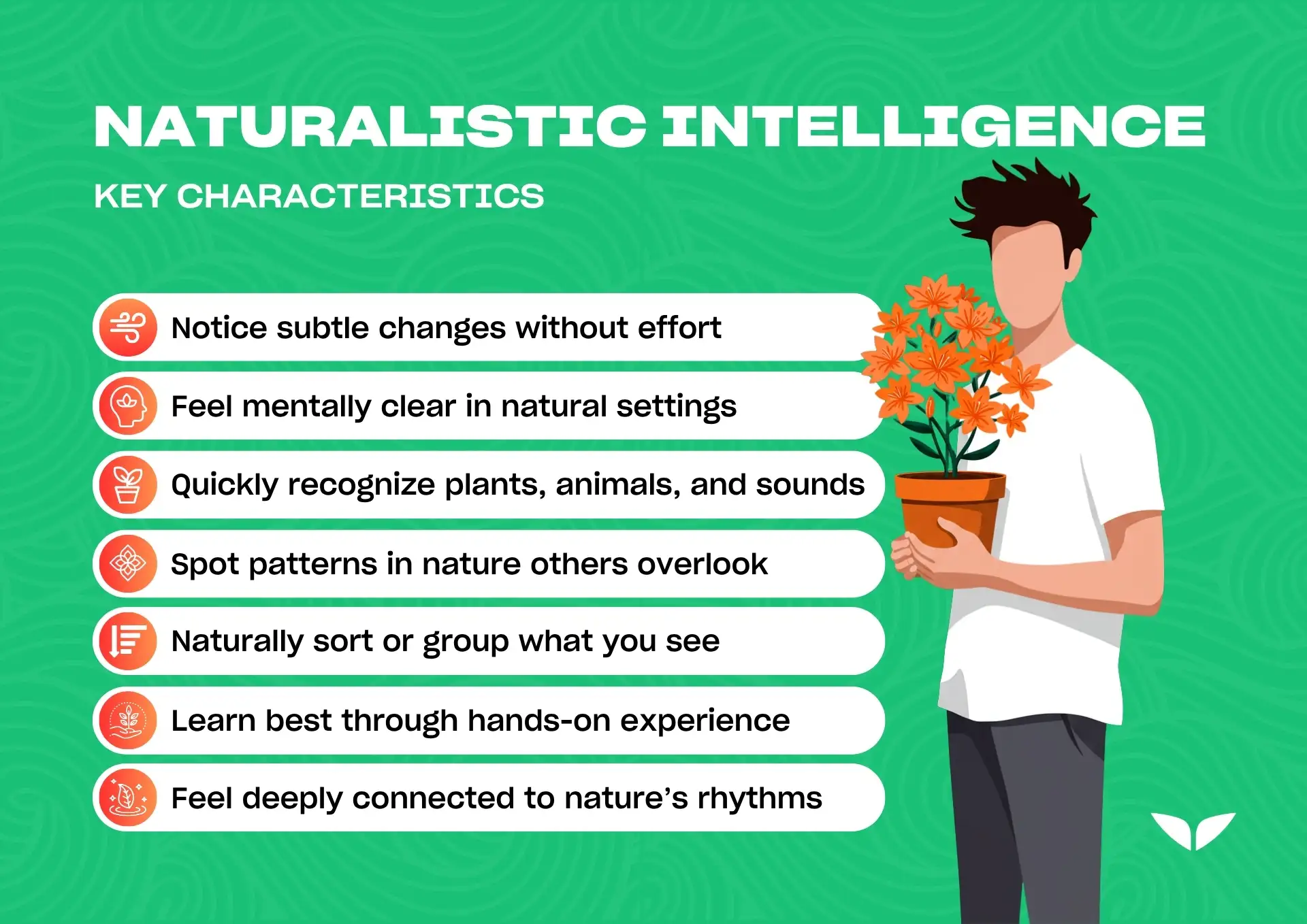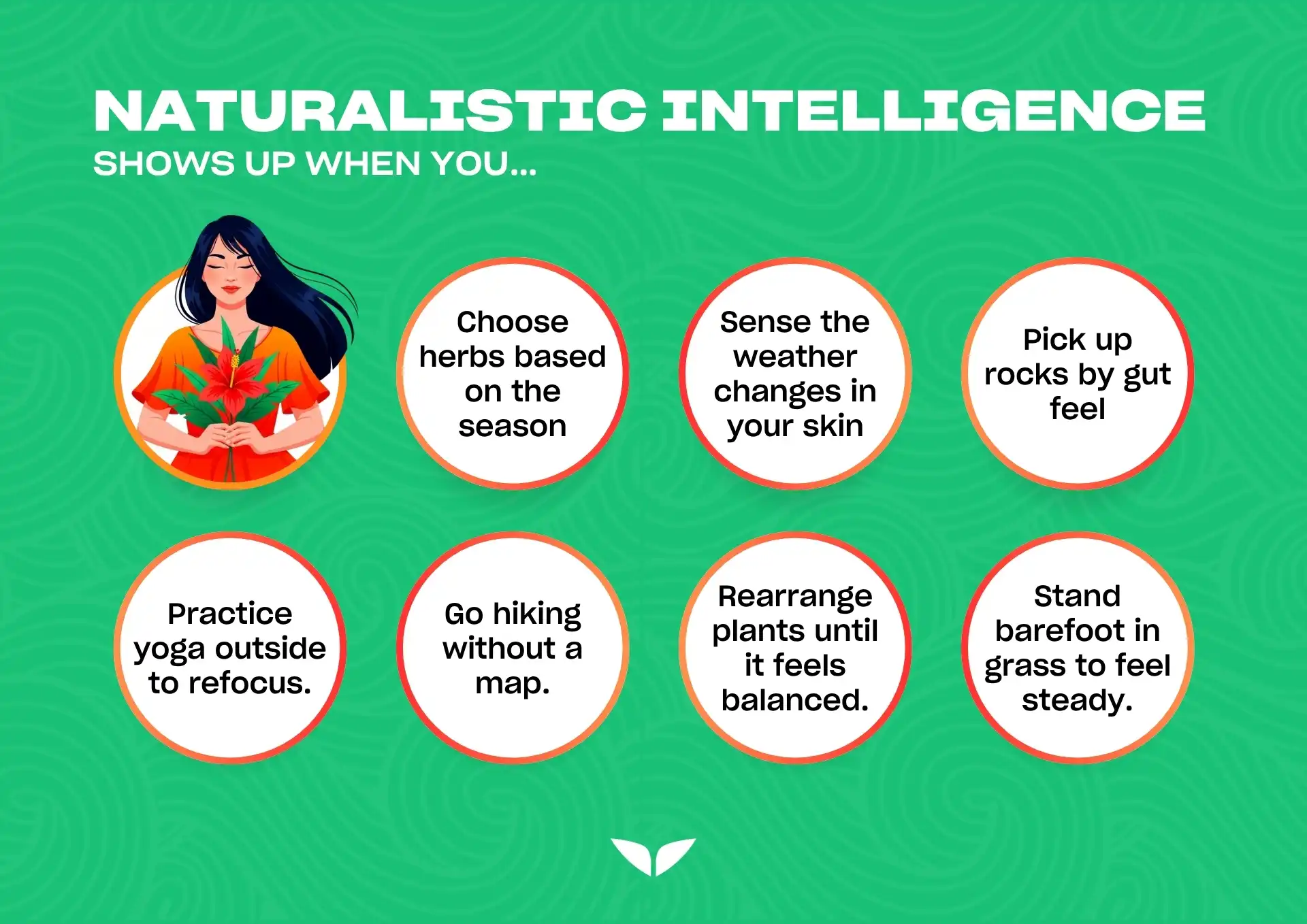Naturalistic intelligence is the bit of your brain that clocked the rustle in the bushes before we had words for “run!” It’s how humans stayed alive long enough to invent oat milk.
Chances are, you’ve probably felt it standing by a river, staring at clouds, leaning against a tree… Your thoughts slow down, and your body feels like it’s finally been heard.
Listening to nature sounds, bird songs, or flowing water certainly will help most people calm your mind and soothe your emotions.
— Jim Kwik, trainer of Mindvalley’s Superbrain program
Whether it’s second nature to you or something you’ve barely noticed, this part of your brain is still yours to use. And the more you tune into it, the sharper your brain gets.
What is naturalistic intelligence?
The term itself might sound technical, but the “naturalistic intelligence” definition is surprisingly grounded. It describes how your brain interacts with the natural world: how you spot patterns in a landscape, pick up on tiny changes in plants or animals, and sort through that information using your senses more than your screens.
It’s one of developmental psychologist Howard Gardner’s nine types of intelligence. Unlike the ones that get praised in school reports, this one rarely gets the spotlight. It’s quiet, and it works in the background. But it’s been keeping humans alert, adaptable, and mentally sharp for longer than written language has existed.
That’s the thing about being in nature: it helps the brain reset, making it easier to focus, remember things, and think clearly. A 2012 study led by brain scientist Dr. David Strayer found that people who spent four days out in nature with no phones or screens did 50% better on a test that measured creative problem-solving.
His more recent research shows the same effect in a shorter time frame: just 40 minutes in nature was enough to boost executive control in the brain, helping people shift attention, spot patterns, and recover from mental fatigue. Which is especially useful when daily life demands constant multitasking, screen-swiping, and mental gear-shifting with no real pause.
So when you neglect your green thinking, you’re operating with only part of the toolkit. But pay attention to it, and your perception starts to recalibrate in ways you can feel.
Gardner’s theory of multiple intelligences
In the early 1980s, Gardner introduced a new way of thinking about the mind. He argued that instead of a single IQ, humans have many different types of intelligence that shape how we learn, solve problems, and connect with the world.
Here are the nine types he identified:
- Linguistic: You connect through words, and reading, writing, or speaking all come naturally.
- Logical-mathematical: You like figuring things out, spotting patterns, and making sense of numbers.
- Musical: You pick up on rhythm, melody, and sound without needing to try.
- Kinesthetic: You think best when you’re moving, because your body is part of how you process the world.
- Visual-spatial: You see in shapes and layouts and instinctively know how to arrange things.
- Interpersonal: You read people well and understand what’s going on beneath the surface.
- Intrapersonal: You spend time in your inner world, and you’re good at naming what you feel.
- Naturalistic: You notice things in nature that most people overlook.
- Existential: You’ve always had an eye on the big questions, like life, death, meaning, and time.
Each of these intelligences plays out differently in daily life. Some show up in how you think; others in what you notice without trying.
And naturalistic intelligence often starts with the smallest details.
Key characteristics
Having the intelligence of the wild isn’t just some “nature lover” quirk. When it’s switched on, it can rewire how you pay attention to the world. Like, you might:
- Notice small changes in your environment without thinking about it
- Feel more focused or calm in natural spaces
- Be quick to recognize animals, plants, weather patterns, or natural sounds
- Pick up patterns in your surroundings that others miss
- Instinctively sort, group, or classify things, like leaves, rocks, or even ideas
- Learn best through touch, sight, sound, and real-world experience
- Feel a strong connection to seasons, ecosystems, or cycles in nature
You don’t need to live in the woods to tap your naturalistic intelligence. According to brain coach Jim Kwik, even listening to birdsong or running water can calm the mind and support mental clarity.
In one of his YouTube videos, he explains that “listening to nature sounds, bird songs, or flowing water certainly will help most people calm your mind and soothe your emotions.” And that’s especially true if you’re experiencing high levels of stress.

Why is naturalistic intelligence important?
Ask anyone who feels overwhelmed, overstimulated, or like their brain’s on twenty tabs at once, and they’ll tell you: something’s missing. Usually, it’s connection. Not to Wi-Fi, but to something slower, steadier, and built into the nervous system.
That’s where your nature smarts can help. It sharpens your ability to notice and brings your focus back to the rhythms of life that existed long before calendars and notifications.
Tapping into the intelligence of nature helps us to understand life.
— Ben Fizell, founder of the Peacekeeper Project
According to Ben Fizell, the founder of the Peacekeeper Project, nature helps create a sense of steadiness, helps you feel more in your body, and opens you up to fresh insights, which makes it easier to learn and process emotions.
“One of the problems with emotional work is that we get too caught in the stories in our head,” he explains to Pulse. That in and of itself can be very challenging. However, when we feel calm and supported just by being in nature, “it can help us to go deeper into our self, to feel our emotions, or have conversations that might be more challenging otherwise.”
Now, if you’ve ever paused to ask, what does naturalistic intelligence mean?, this is it. It’s your brain’s built-in way to reorient through cues from the living world: light, sound, movement, and the feel of the seasons.
“Tapping into the intelligence of nature helps us to understand life,” Ben adds. “Whatever we do and wherever we go, we all have to navigate life.”
And nature? It helps you live with more energy, health, and meaning.
Famous people with naturalistic intelligence
“Somebody who’s really connected with nature understands the science of nature,” Jim points out. And here are a few who embody it:
- Charles Darwin, who tracked patterns across continents and built a theory that reshaped science.
- Jane Goodall, whose quiet patience in the wild changed how we understand primates and ourselves.
- David Attenborough, whose life’s work invites millions to see nature not as background, but as teacher.
- Louie Schwartzberg, the filmmaker whose time-lapse lens reveals the unseen rhythms of nature and makes people feel wonder again.
- Temple Grandin, who used her deep sensitivity to animals to transform the livestock industry.
- Wangari Maathai, the Nobel Peace Prize–winning environmentalist who planted trees and power in Kenya.
- Ben Fizell, the stillness coach (in addition to the Peacekeeper Project founder), who helps people reconnect to presence through nature, meditation, mindfulness, and deep listening.
“Our ability to recognize and classify features of our environment rests on our power of discernment, which can be used to understand nature, but it can be used to understand anything,” Ben says. “For example, to do deep inner work and understand our emotions and patterns of behavior requires discernment.”
When you start noticing the world like this, even a walk down the street teaches you something.
Naturalistic intelligence examples in action
Having a sensory connection to nature often shows up as quiet, bodily, and instinctive. You may not even realize how often you lean on it, like:
- Sensing when a dish needs rosemary instead of thyme, based on the feel of the season.
- Feeling the weather in your skin before checking the forecast even crosses your mind.
- Choosing rocks by feel, not reason, because something in them just fits in your hand like it belongs there.
- Practicing mindful yoga outside where the air, sounds, and ground help you focus.
- Finding the trail without using a map. Your body just knows where to go.
- Rearranging plants in the garden until the layout feels balanced.
- Kicking off your shoes to stand on the grass.
Each one of these naturalist intelligence activities can be found in daily life. And the thing is, your brain already knows how to listen to the natural world. It just needed the reminder.

9 career paths for people with naturalistic intelligence
If you’re tuned into the natural world and notice things others miss, naturalistic intelligence careers might be a perfect fit. They’re made for people who think in ecosystems, patterns, and living systems.
Here are nine you can look into if you’re looking for a role that fits how your mind works or a career change:
- Ecologist: You study how plants, animals, and people interact, often in the field where the action happens.
- Botanist: You get up close with plants, not just naming them but understanding how they live, grow, and communicate.
- Environmental educator: You help others see what they’ve been missing in the natural world and why it matters.
- Park ranger: You protect natural spaces while guiding others through them with skill, knowledge, and instinct.
- Wildlife biologist: You track animal behavior in the wild, noticing patterns others overlook.
- Sustainability consultant: You bring a systems-level view to companies and communities trying to reduce environmental harm.
- Outdoor adventure guide: You read landscapes like a book and help others safely explore them.
- Permaculture designer: You create gardens and living systems that mimic nature’s rhythms to support people and the planet.
- Nature-based therapist or coach: You use the outdoors as a space for healing, growth, and reconnection.
Ben’s work is a great example. As someone who helps others reconnect through stillness, he blends meditation, emotional awareness, and nature-based presence.
“The intelligence and cycles of nature are part of us,” he says. “It’s only our mind that makes us feel separate.”
How to improve naturalistic intelligence
If your brain feels wired for noise, this kind of intelligence brings it back to signal.
While Jim, in his Superbrain program on Mindvalley, doesn’t specifically focus on nature-centric techniques, he does often share everyday habits that sharpen your brain by reconnecting it to the world around you.
And there’s no reason you can’t use them to strengthen your naturalistic intelligence.
1. Begin your morning outside
There’s a reason being outdoors is so refreshing, especially in the morning. It helps calm electrical activity in the brain. That, in turn, can help regulate your circadian rhythm, oxygen levels, and cognitive speed.
And that’s why it’s something Jim recommends doing. He himself gets in the four elements first thing in the morning. That is…
- Air with breathwork outside to oxygenate his brain and body.
- Water to rehydrate after sleep.
- Fire by exposing himself to natural sunlight to reset his circadian rhythm.
- Earth by taking off his shoes and standing barefoot on the grass to ground himself.
“The great thing about these elements is they’re free,” Jim adds. And they train your brain to tune in before the world starts pulling at your attention.
2. Move with awareness
As you’re out there soaking up the elements, add in a little movement. Because, as Jim is known to say, “As your body moves, your brain grooves.”
You see, even though it’s often referenced to it, your brain isn’t a computer. It’s a movement-powered, rhythm-sensitive, oxygen-hungry organ. And it loves it when you stop sitting like a stale baguette and actually move.
Jim suggests doing a little brain gym, simple cross-body movements like tapping your left knee with your right hand. This activates both sides of your brain and strengthens neural connections across the corpus callosum (that’s the middle part of your brain that connects both hemispheres and gets them to talk to one another).
“Anything that crosses the midline,” he says, “helps to develop that left and right brain connection.”
3. Turn nature into a memory tool
What if your surroundings could store your to-do list, your grocery list, or the main points of your next big idea? That’s what Jim teaches with his “location method,” a powerful brain trick that helps you remember more by turning physical spaces into mental filing cabinets.
Here’s how it works:
- Pick a familiar route, like the path through your garden, a walk around your block, or even your go-to morning trail.
- Then, assign pieces of information to spots along that route. Your front gate might hold the first step of your presentation. The flowerpot could hold the second. Your neighbor’s mailbox? That’s the third.
- When it’s time to recall it, you simply walk the path in your mind.
It’s a form of visualization to help remember long lists, speeches, and even languages. And it works even better when you anchor it to something tactile, visual, or alive, like a tree, a curve in the path, or a bed of roses.
BONUS: Reconnect to the moment
Before you race into your day, take a minute to pause, look around, and feel where you are.
This is one of the simplest ways to train your naturalistic intelligence. It begins with reconnecting to your immediate environment. Notice the air moving across your skin, the texture of the ground under your feet, or the quiet hum of life around you.
Jeffrey Allen, a renowned energy healer and the trainer of Mindvalley’s Unlocking Transcendence program, guides a meditation where he invites you to “feel your connection with nature and the planet and really feel grateful for being alive right now.”
Here’s how:
- Feel your connection to the air, the water, the minerals, and the earth.
- Bring your awareness to the plants and animals around you.
- Imagine your body as part of the earth—some water, some air, some ground.
- Ask yourself, “How connected am I to nature right now?”
- Breathe in the air.
- Breathe out gratitude.
- Repeat.
- Smile, open your eyes, and carry that awareness with you.
This practice might only take a minute, but it tells your whole nervous system, I’m here now.
Mindvalley members can access this meditation under the Resources tab of Jeffrey’s program, Unlocking Transcendence.
Unleash your limitless
There’s a kind of intelligence that wakes up when your mind stops racing and your senses finally catch up. But the truth is, it’s only one part of the bigger system running your brain.
To train the rest of it and to actually retain what you learn, Jim Kwik’s free Superbrain masterclass is where you can start.
In just 87 minutes, you’ll learn:
- Why most people only use a fraction of their cognitive potential,
- A 5-minute brain hack that rewires your focus with a toothbrush,
- The 10 foods that sharpen memory and clear brain fog,
- The real reason you keep forgetting things and how to stop, and
- Much, much more.
Jim’s taught so many, from Will Smith to the cast of X-Men. And it’s not surprising that over three million Mindvalley members have taken Superbrain.
That includes brain and life coach Hiba Kabbara from Lebanon, who joined hoping to support her children, especially her 9-year-old son with dyslexia.
I started teaching [my sons] the sun [list] and the chain link and so many more… I recommend this quest to all moms and dads, teachers, students, literary everyone.
That’s the thing: Jim’s techniques work because they’re simple, repeatable, and grounded in how your brain actually works, not how you wish it did. So if you’ve ever wanted to think more clearly, learn more easily, or remember without trying so hard, this is it.
Welcome in.











